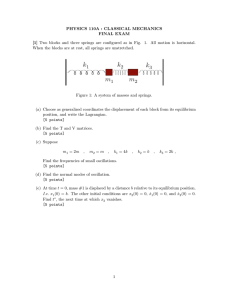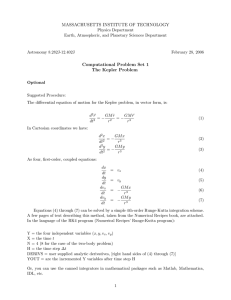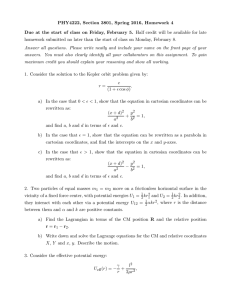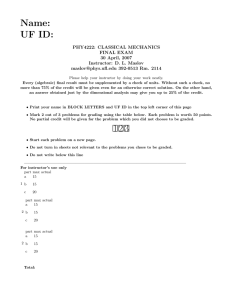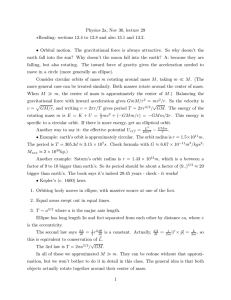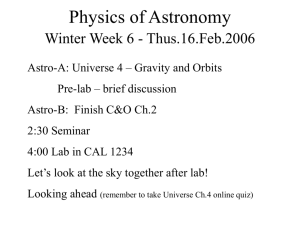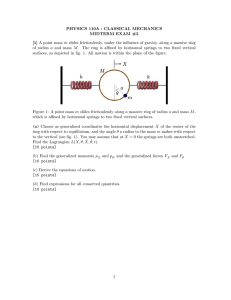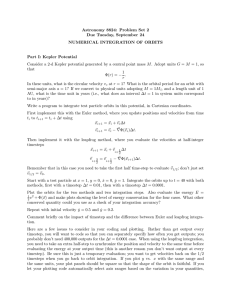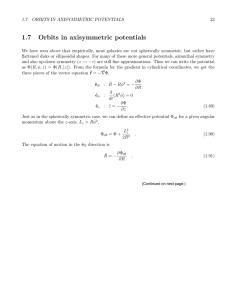(1)
advertisement
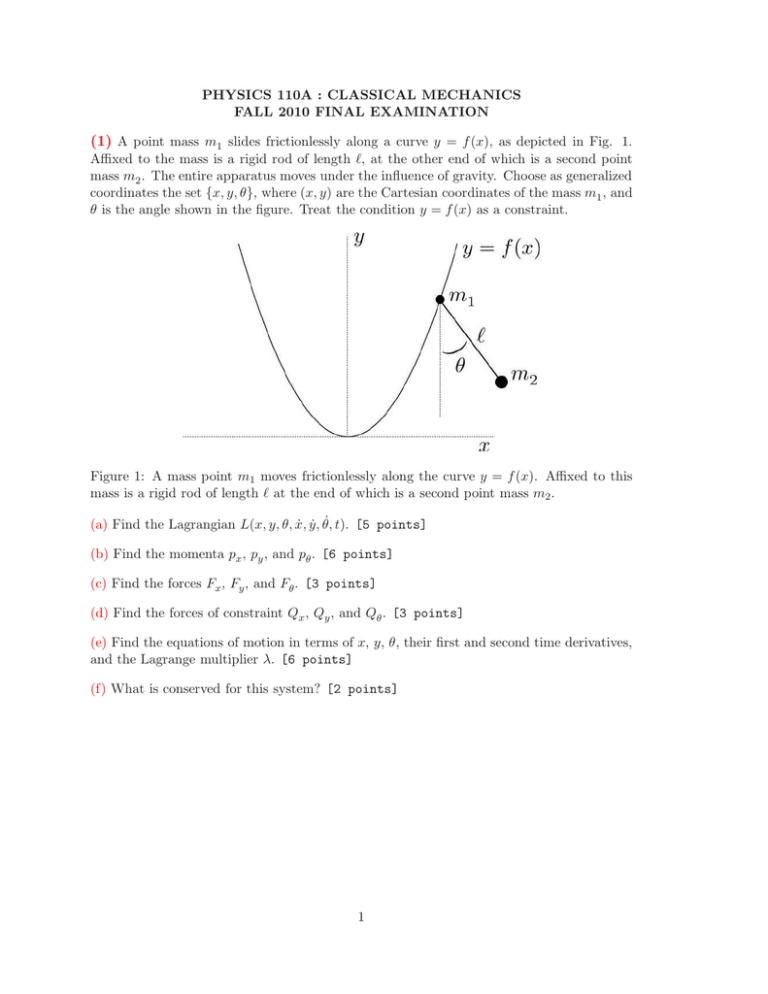
PHYSICS 110A : CLASSICAL MECHANICS
FALL 2010 FINAL EXAMINATION
(1) A point mass m1 slides frictionlessly along a curve y = f (x), as depicted in Fig. 1.
Affixed to the mass is a rigid rod of length ℓ, at the other end of which is a second point
mass m2 . The entire apparatus moves under the influence of gravity. Choose as generalized
coordinates the set {x, y, θ}, where (x, y) are the Cartesian coordinates of the mass m1 , and
θ is the angle shown in the figure. Treat the condition y = f (x) as a constraint.
Figure 1: A mass point m1 moves frictionlessly along the curve y = f (x). Affixed to this
mass is a rigid rod of length ℓ at the end of which is a second point mass m2 .
(a) Find the Lagrangian L(x, y, θ, ẋ, ẏ, θ̇, t). [5 points]
(b) Find the momenta px , py , and pθ . [6 points]
(c) Find the forces Fx , Fy , and Fθ . [3 points]
(d) Find the forces of constraint Qx , Qy , and Qθ . [3 points]
(e) Find the equations of motion in terms of x, y, θ, their first and second time derivatives,
and the Lagrange multiplier λ. [6 points]
(f) What is conserved for this system? [2 points]
1
(2) Treat the system described in problem (1) without the constraint formalism, using
generalized coordinates x and θ. Assume f (x) = f (−x) is a symmetric function with a
single minimum at x = 0, and that f ′′ (0) > 0.
(a) Find the Lagrangian L(x, θ, ẋ, θ̇, t). [5 points]
(b) Find the equilibrium values (x∗ , θ ∗ ) and the T and V matrices. [5 points]
p
p
(c) Consider the case f (x) = x2 /2b. Define Ω0 = g/b and Ω1 = g/ℓ. Find a general
expression for the normal mode frequencies ω± . Then consider the case where m1 = 21m,
m2 = 4m, Ω0 = 3Ω, and Ω1 = 5Ω. Find ω± . [10 points]
(d) Find the eigenvectors ψ (±) . You do not have to normalize them. [5 points]
(3) Two particles of masses m1 and m2 interact via the central potential
U (r1 , r2 ) = −U0
a
|r1 − r2 |
1/2
.
(a) Find and sketch the effective potential Ueff (r). Sketch the phase curves in the (r, ṙ)
plane. Identify any separatrices and find their energies. [5 points]
(b) Find the radius r0 of the circular orbit as a function of the angular momentum ℓ and
other constants. [5 points]
(c) Writing r(t) = r0 + η(t), find the linearized equations of motion for η(t). Find the
frequency ω of the radial oscillations. [5 points]
(d) What is the shape of the nearly circular orbits? What is the shape r(φ) of the nearly
circular orbits? Are those orbits closed? Why or why not? [5 points]
(e) What is the ratio of the escape velocity at r0 to the orbital velocity at r0 ? [5 points]
2
(4) Provide brief but substantial answers to the following questions.
(a) For a system with kinetic and potential energies
,
T = 12 m ẋ2 + ω 2 x2
U = U (x) ,
find the Hamiltonian. Under what conditions is H = T + U ? [5 points]
(b) For central force motion, what is the definition of a bounded orbit? What is a closed
orbit? What are the conditions for a circular orbit, and under what conditions is a circular
orbit stable with respect to small perturbations? Under what conditions is an almost
circular orbit closed? [5 points]
(c) Write down an example of a Lagrangian for a system with two generalized coordinates
(and no constraints), and which yields two and only two conserved quantities. [5 points]
(d) Consider the functional
#
2
Z∞ " 2 2
d
y
dy
F [y(x)] = dx 21 a
+ 12 b
+ 12 cy 2 − j(x) y(x)
dx2
dx
−∞
What is the differential equation which extremizes F [y(x)]? [5 points]
(e) Consider an equilateral triangle composed of three point masses connected by three
springs which moves in a horizontal plane. How many normal modes of oscillation are
there? Some of the normal modes involve no restoring force. Can you identify the type of
motion for these three ‘zero modes’ ? [5 points]
3
